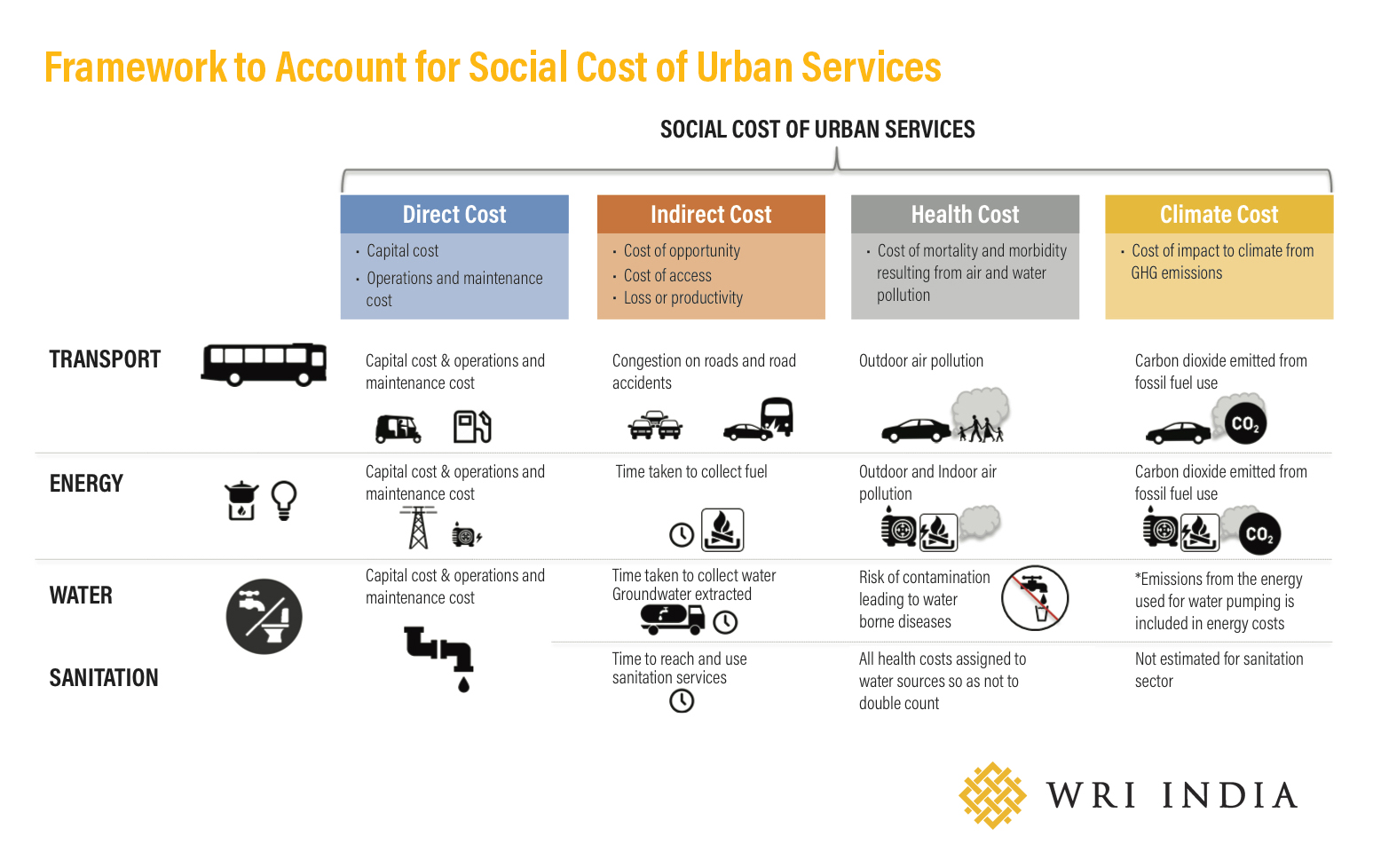Social Cost Accounting for Urban Service Provision
by -As one of the fastest growing countries, urbanisation has emerged as an opportunity and a challenge for India with huge implications for the rest of the world. Between 2001 and 2015, the number of cities in India with a population of a million or more increased from 35 to 53. In 2015, India’s urban population reached 420 million – 33 per cent of the total population. This number is expected to double to 800 million by 2050 when one in every two Indians will live in its towns and cities.
The social costs of growth
Today India’s cities not only face severe infrastructure bottlenecks and service level deficits that undercut economic performance, but poorly managed urban growth also directly impacts health and quality of life of citizens. Worsening air pollution in Indian cities is estimated to have caused 620,000 premature deaths each year. It also adds significantly to overall carbon emissions and close to half of India’s net greenhouse gas emissions originate in urban areas.
Rapid urban expansion in India primarily in peri-urban areas and is not only unplanned, but also almost entirely lacking in public services like water, sewer, power and other cirtical infrastructure, including reasonable access to transit. This reinforces the vicious cycle of ever-deeper reliance by households, firms and industries on unmanaged groundwater extraction, private vehicle ownership, and polluting diesel power generators to meet basic needs.
The social cost accounting approach
With rapid unplanned growth spreading across Indian cities, public interventions seem unable to stem the tide of negative externalities that arise, such as congestion, air pollution, water contamination and consequent health challenges. There is urgent need for new tools and practices that can aid cities assess their current conditions and evaluate possibilities of change towards sustainable urbanisation.
In a new report, Towards Smarter Service Provision for SMART Cities: Accounting for the Social Costs of Urban Services, WRI India approaches India’s urban issues from the aspect of assessing delivery mechanisms of selected services at the municipal level, looking in-depth at four case study cities – Bangalore, Indore, Pune and Surat.
Using a Social Cost Accounting (SCA) methodology, the market and non-market costs associated with the delivery of water, sanitation, transport and energy services in the case study cities was estimated.

Alongside direct costs for various services the study also emphasises attention to often ignored social costs (indirect costs, health costs and environmental costs). Each type of service provision is categorised into public, private and self-provision across the three sectors and explored further.
The example of water
The study found that all four cities have been urbanising rapidly and have seen an increase in population and municipal boundaries. While these four cities report high aggregate levels of access to public services, there is significant variation within and between them. For example, despite high aggregate levels of access in Bangalore, more than 50 percent of the total water demand is met by groundwater from private tube wells and boreholes, and vended water. There are many reasons for these coping activities; intermittent supply and inability of the public utility to increase coverage or improve service quality are just some of them.

In the case of water, for example, we found that vended water and borewell water can have 2-68 times the social cost of public provided water (Figure 4). In Pune and Surat where public provided water accounts for 98 percent and 97 percent of the total quantity of water supplied, this might not pose as much a problem as in Bangalore and Indore where public water accounts for 48 percent and 42 percent respectively.
The way forward
Many national and sub-national programmes, such as AMRUT – India’s Smart Cities Mission, have been established to improve quality of service to urban residents. Existing evaluation metrics for these initiatives continue to focus on the supply-side of public service provision, in terms of network coverage and do not account for quality of service. So, while government initiatives envision progressive urban infrastructure projects, the continued focus on supply-side management using these indicators leads to business as usual solutions to be adopted. There is limited uptake of practices which can enhance sustainability outcomes such as demand management, reduced resource use and shift to renewable resources.
A Social Cost Accounting (SCA) approach, as demonstrated in this paper, should be adopted as a city tool to analyse services in cities so that interactions between different services across multiple sectors are mapped and better understood. Alongside policy and planning changes, new financing tools to fund urban infrastructure and services should be made available. Regulatory environments involving right pricing of services and incentives that encourage innovation and discourage high-carbon, high resource using alternatives should be enabled.



Add new comment